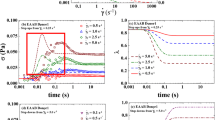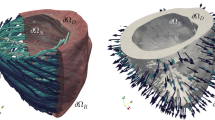Abstract
Understanding tissue rheology is critical to accurately model the human heart. While the elastic properties of cardiac tissue have been extensively studied, its viscous properties remain an issue of ongoing debate. Here we adopt a viscoelastic version of the classical Holzapfel Ogden model to study the viscous timescales of human cardiac tissue. We perform a series of simulations and explore stress–relaxation curves, pressure–volume loops, strain profiles, and ventricular wall strains for varying viscosity parameters. We show that the time window for model calibration strongly influences the parameter identification. Using a four-chamber human heart model, we observe that, during the physiologically relevant time scales of the cardiac cycle, viscous relaxation has a negligible effect on the overall behavior of the heart. While viscosity could have important consequences in pathological conditions with compromised contraction or relaxation properties, we conclude that, for simulations within the physiological range of a human heart beat, we can reasonably approximate the human heart as hyperelastic.









Similar content being viewed by others
References
AHA Statistical Update (2020) Heart disease and stroke statistics—2020 update: a report from the American Heart Association. Circulation 141:e139–e596
Alber M, Buganza Tepole A, Cannon W, De S, Dura-Bernal S, Garikipati K, Karniadakis G, Lytton WW, Perdikaris P, Petzold L, Kuhl E (2019) Integrating machine learning and multiscale modeling: perspectives, challenges, and opportunities in the biological, biomedical, and behavioral sciences. npj Digit Med 2:115
Aliev RR, Panfilov AV (1996) A simple two-variable model of cardiac excitation. Chaos Solitons Fractals 7(3):293–301
Ambrosi D, Pezzuto S (2012) Active stress vs. active strain in mechanobiology: constitutive issues. J Elast 107:199–212
Baillargeon B, Rebelo N, Fox DD, Taylor RL, Kuhl E (2014) The living heart project: a robust and integrative simulator for human heart function. Eur J Mech A/Solids 48:38–47
Berberoğlu E, Solmaz HO, Göktepe S (2014) Computational modeling of coupled cardiac electromechanics incorporating cardiac dysfunctions. Eur J Mech A/Solids 48:60–73
Cansız B, Dal H, Kaliske M (2015) An orthotropic viscoelastic material model for passive myocardium: theory and algorithmic treatment. Comput Methods Biomech Biomed Eng 18:1160–1172
Cansız B, Dal H, Kaliske M (2017) Computational cardiology: a modified Hill model to describe the electro-visco-elasticity of the myocardium. Comput Methods Appl Mech Eng 315:434–466
Cansız B, Sveric K, Ibrahim K, Strasser RH, Linke A, Kaliske M (2018) Towards predictive computer simulations in cardiology: finite element analysis of personalized heart models. ZAMM-J Appl Math Mech 98–12:2155–2176
Chabiniok R, Wang V, Hadjicharalambous M, Asner L, Lee J, Sermesant M, Kuhl E, Young A, Moireau P, Nash M, Chapelle D, Nordsletten DA (2016) Multiphysics and multiscale modeling, data-model fusion and integration of organ physiology in the clinic: ventricular cardiac mechanics. Interface Focus 6:20150083
Dal H, Göktepe S, Kaliske M, Kuhl E (2012) A fully implicit finite element method for bidomain models of cardiac electrophysiology. Comput Methods Biomech Biomed Eng 15–6:645–656
Dal H, Göktepe S, Kaliske M, Kuhl E (2013) A fully implicit finite element method for bidomain models of cardiac electromechanics. Comput Methods Appl Mech Eng 253:323–336
Dal H (2019) A quasi-incompressible and quasi-inextensible element formulation for transversely isotropic materials. Int J Numer Methods Eng 117:118–140
Dokos S, Smaill BH, Young AA, LeGrice IJ (2002) Shear properties of passive ventricular myocardium. Am J Physiol Heart Circ Physiol 283:H2650–H2659
Eriksson TS, Prassl AJ, Plank G, Holzapfel GA (2013) Modeling the dispersion in electromechanically coupled myocardium. Int J Numer Methods Biomed Eng 29:1267–1284
Genet M, Lee LC, Baillargeon B, Guccione JM, Kuhl E (2016) Modeling pathologies of systolic and diastolic heart failure. Ann Biomed Eng 44:112–127
Göktepe S, Kuhl E (2009) Computational modeling of electrophysiology: a novel finite element approach. Int J Numer Methods Eng 79:156–178
Göktepe S, Kuhl E (2010) Electromechanics of the heart—a unified approach to the strongly coupled excitation–contraction problem. Comput Mech 45:227–243
Göktepe S, Acharya SNS, Kuhl E (2011) Computational modeling of passive myocardium. Int J Numer Methods Biomed Eng 27:1–12
Göktepe S, Menzel A, Kuhl E (2014) The generalized Hill model: a kinematic approach towards active muscle contraction. J Mech Phys Solids 72:20–39
Granzier HL, Siegfried L (2004) The giant protein titin: a major player in myocardial mechanics, signaling, and disease. Circ Res 94:284–295
Guccione JM, Moonly SM, Moustakidis P, Costa KD, Moulton MJ, Ratcliffe MB, Pasque MK (2001) Mechanism underlying mechanical dysfunction in the border zone of left ventricular aneurysm: a finite element model study. Ann Thorac Surg 71:654–662
Gültekin O, Sommer G, Holzapfel GA (2016) An orthotropic viscoelastic model for the passive myocardium: continuum basis and numerical treatment. Comput Methods Biomech Biomed Eng 19:1647–1664
Gültekin O, Dal H, Holzapfel GA (2019) On the quasi-incompressible finite element analysis of anisotropic hyperelastic materials. Comput Mech 63:443–453
Helfenstein J, Jabareen M, Mazza E, Govindjee S (2010) On non-physical response in models for fiber-reinforced hyperelastic materials. Int J Solids Struct 47:2056–2061
Hill AV (1938) The heat of shortening and the dynamic constants of muscle. Proc R Soc Lond Ser B Biol Sci 126:136–195
Holzapfel GA, Simo JC (1996) A new viscoelastic constitutive model for continuous media at finite thermomechanical changes. Int J Solids Struct 33:3019–3034
Holzapfel GA (2002) Nonlinear solid mechanics: a continuum approach for engineering science. Meccanica 37(4):489–490
Holzapfel GA, Ogden RW (2009) Constitutive modelling of passive myocardium: a structurally based framework for material characterization. Philos Trans R Soc Lond 367:3445–3475
Humphrey JD, Strumpf RK, Yin FCP (1990) Determination of a constitutive relation for passive myocardium: I. A new functional form
Kaliske M (2000) A formulation of elasticity and viscoelasticity for fibre reinforced material at small and finite strains. Comput Methods Appl Mech Eng 185:225–243
Liu J, Marsden AL (2018) A unified continuum and variational multiscale formulation for fluids, solids, and fluid-structure interaction. Comput Methods Appl Mech Eng 337:549–597
McEvoy E, Holzapfel GA, McGarry P (2018) Compressibility and anisotropy of the ventricular myocardium: experimental analysis and microstructural modeling. J Biomech Eng 140:081004
Nash MP, Panfilov AV (2004) Electromechanical model of excitable tissue to study reentrant cardiac arrhythmias. Prog Biophys Mol Biol 85:501–522
Nedjar B (2007) An anisotropic viscoelastic fibre-matrix model at finite strains: continuum formulation and computational aspects. Comput Methods Appl Mech Eng 196:1745–1756
Nordsletten D, Capilnasiu A, Zhang W, Wittgenstein A, Hadjicharalambous M, Sommer G, Sinkus R, Holzapfel GA (2021) A viscoelastic model for human myocardium. arXiv preprint arXiv:2105.06671
Ostwald R, Kuhl E, Menzel A (2019) On the implementation of finite deformation gradient-enhanced damage models. Comput Mech 64:847–877
Peirlinck M, De Beule M, Segers P, Rebelo N (2018) A modular inverse elastostatics approach to resolve the pressure-induced stress state for in vivo imaging based cardiovascular modeling. J Mech Behav Biomed Mater 85:124–133
Peirlinck M, Costabal FS, Sack KL, Choy JS, Kassab GS, Guccione JM, De Beule M, Segers P, Kuhl E (2019) Using machine learning to characterize heart failure across the scales. Biomech Model Mechanobiol 18:1987–2001
Peirlinck M, Costabal FS, Yao J, Guccione JM, Tripathy S, Wang Y, Ozturk D, Segars P, Morrison TM, Levine S, Kuhl E (2021) Precision medicine in human heart modeling. Biomech Model Mechanobiol 20:803–831
Peirlinck M, Yao J, Sahli Costabal F, Kuhl E (2022) How drugs modulate the performance of the human heart. Comput Mech. https://doi.org/10.1007/s00466-022-02146-1
Rubiano A, Qi Y, Guzzo D, Rathinasabapathy A, Rowe K, Pepine C, Simmons C (2016) Stem cell therapy restores viscoelastic properties of myocardium in rat model of hypertension. J Mech Behav Biomed Mater 59:71–77
Sahli Costabal F, Hurtado DE, Kuhl E (2016) Generating Purkinje networks in the human heart. J Biomech 49(12):2455–2465
Sahli Costabal F, Concha FA, Hurtado DE, Kuhl E (2017) The importance of mechano-electrical feedback and inertia in cardiac electromechanics. Comput Methods Appl Mech Eng 320:352–368
Sommer G, Schriefl AJ, Andrä M, Sacherer M, Viertler C, Wolinski H, Holzapfel GA (2015) Biomechanical properties and microstructure of human ventricular myocardium. Acta Biomaterialia 24:172–192
Sommer G, Haspinger DC, Andrä M, Sacherer M, Viertler C, Regitnig P, Holzapfel GA (2015) Quantification of shear deformations and corresponding stresses in the biaxially tested human myocardium. Ann Biomed Eng 43:2334–2348
St Pierre SR, Peirlinck M, Kuhl E (2022) Sex matters: a comprehensive comparison of female and male hearts. Front Physiol 13:831179
Stroud JD, Baicu CF, Barnes MA, Spinale FG, Zile MR (2002) Viscoelastic properties of pressure overload hypertrophied myocardium: effect of serine protease treatment. Am J Physiol Heart Circ Physiol 282:H2324–H2335
Updegrove A, Wilson NM, Merkow J, Lan H, Marsden AL, Shadden SC (2017) SimVascular: an open source pipeline for cardiovascular simulation. Ann Biomed Eng 45(3):525–541
Walker JC, Ratcliffe MB, Zhang P, Wallace AW, Fata B, Hsu EW, Saloner D, Guccione JM (2005) MRI-based finite-element analysis of left ventricular aneurysm. Am J Physiol Heart Circ Physiol 289:H692–H700
Yang M, Taber LA (1991) The possible role of poroelasticity in the apparent viscoelastic behavior of passive cardiac muscle. J Biomech 24:587–597
Yao J, Varner VD, Brilli LL, Young JM, Taber LA, Perucchio R (2012) Viscoelastic material properties of the myocardium and cardiac jelly in the looping chick heart. J Biomech Eng 134:024502
Zygote Media Group Inc. (2014) Zygote solid 3D heart generations I & II development report. Technical development of 3D anatomical systems
Acknowledgements
We acknowledge support through the NSF Grant SI2-SSI 1663671 ‘The SimCardio open source multi-physics cardiac modeling package’ and the NIH Grant R01 HL131823 ‘A new framework for understanding the mechanisms of diastolic dysfunction’.
Author information
Authors and Affiliations
Corresponding author
Additional information
Publisher's Note
Springer Nature remains neutral with regard to jurisdictional claims in published maps and institutional affiliations.
Rights and permissions
About this article
Cite this article
Tikenoğulları, O.Z., Costabal, F.S., Yao, J. et al. How viscous is the beating heart? Insights from a computational study. Comput Mech 70, 565–579 (2022). https://doi.org/10.1007/s00466-022-02180-z
Received:
Accepted:
Published:
Issue Date:
DOI: https://doi.org/10.1007/s00466-022-02180-z




